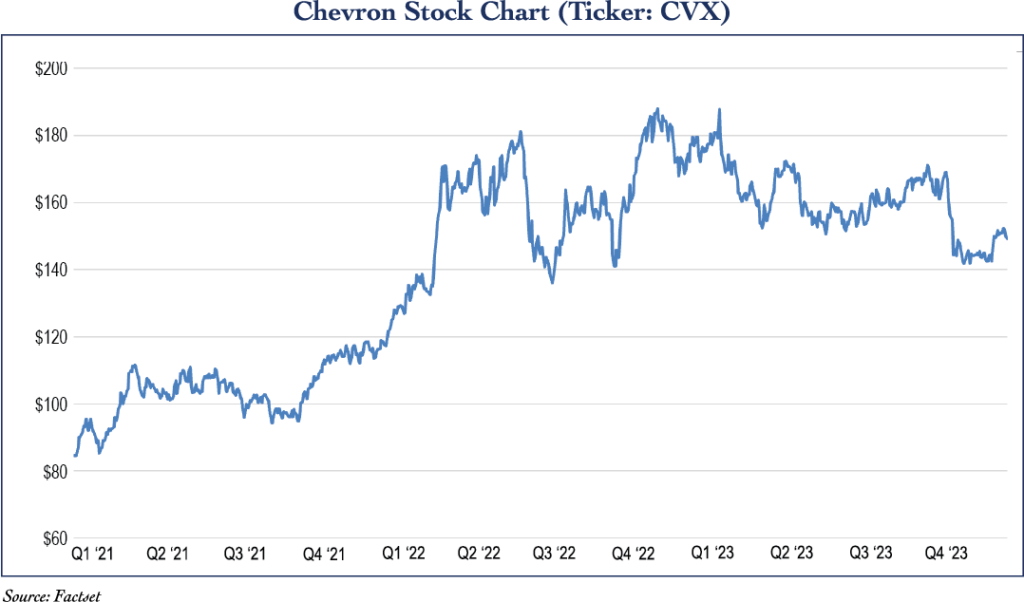Company Spotlight: Chevron (Ticker: CVX)
By: Alex Olshanskiy
Chevron (ticker: CVX) is the second-largest integrated oil & gas company in the United States. Only Exxon Mobil Corporation (ticker: XOM) is larger. Chevron’s two largest business segments are exploration and production (upstream) and refining, marketing and transportation (downstream).
Chevron’s (upstream) operations yield a daily output of 3.0 million barrels of oil equivalent, encompassing 7.7 million cubic feet of natural gas and 1.8 million barrels of liquids. Production activities are spread across North America, South America, Europe, Africa, Asia and Australia. On the (downstream) side, the company’s refineries, located in the U.S. and Asia, have the capacity to process 1.8 million barrels of crude oil per day.
Proved reserves at Chevron stood at 11.2 billion barrels of oil equivalent and 30.9 trillion cubic feet of natural gas, while Exxon by comparison had 17.7 billion barrels of oil equivalent and 37.6 trillion cubic feet of natural gas. Proved reserves represent the estimated amount of oil and natural gas that a company reasonably expects to extract profitably from its reserves. Think of these reserves as the company’s bank account of readily available oil wealth.
Chevron faced challenges in 2023. There was a significant decline in oil prices in 2023 after the previous highs of 2022. Recessionary fears increased global oil supply, and weakened demand from China directly impacted Chevron’s revenue and profitability. Despite robust operational performance, quarterly earnings fell short of analysts’ expectations, which dampened investor sentiment.
The petroleum industry’s operations and profitability hinge on various factors, with prices determined by the supply-demand dynamic for crude oil, natural gas, liquified natural gas (LNG), petroleum products and petrochemicals. OPEC, the Organization of the Petroleum Exporting Countries, is a coalition of major oil-producing nations that coordinates oil production and stabilizes prices.
OPEC+ is an expanded alliance that includes OPEC in addition to other non-OPEC members—most notably Russia. By adjusting input, these two groups aim to stabilize prices and safeguard the interests of member countries. OPEC+ oil producers recently agreed to voluntary cut oil production totaling about 2.2 million barrels per day (bpd) for early 2024, and these cuts could be extended if needed. The impact of these cuts could lead to potential price hikes which could favorably affect Chevron’s future revenue.
In a bold strategic move, Chevron acquired PDC Energy and proposed an acquisition of Hess Corporation. Despite investor apprehension, the consolidation of the oil and gas industry is seen as positive by Tufton. Furthermore, heightened global economic concerns, including rising inflation and potential recession risks, might have caused investors to shy away from oil stocks, redirecting their attention towards alternative energy companies. The last time energy stocks faced such skepticism was in 2020, and those who invested during that time reaped rewards.
Chevron’s announcement in October 2023 regarding the acquisition of Hess Corporation (ticker: HES) in a $53 billion all-stock transaction is expected to conclude in the first quarter of 2024. CEO Mike Wirth of Chevron underscores the significance of this strategic move, emphasizing its importance not only for the company but also for American energy, job creation and energy security. The addition of Hess brings valuable assets into Chevron’s portfolio, notably in the Stabroek block in Guyana, showcasing one of the most significant oil discoveries in the past decade. With estimated recoverable resources surpassing 9 billion barrels of oil equivalent, Chevron will also gain access to acreage in both the DJ Basin and the Permian Basin, strategically positioning the company for future growth. Despite the potential for share dilution, Chevron’s steadfast share buybacks serve as a reassuring countermeasure. Our internal calculations indicate positive developments in Chevron’s proved reserves and daily production numbers.
Acknowledging the challenges of 2023, we believe Chevron’s fundamental principles remain intact. The company delivers an annual dividend of $6.04, or a 4% yield, surpassing the S&P 500’s approximately 1.5% yield. Recent strategic moves, such as the closure of PDC Energy and the impending addition of Hess, contribute to the company’s consolidation efforts in the upstream sector, leading to a growth in daily production, the expansion of proved reserves and the acquisition of valuable assets. Chevron’s adept management of elevated oil prices has facilitated debt reduction, and with disciplined capital practices, the company continues to improve its liquidity and solvency ratios. This improves its operational efficiency and enables increased cash flow for reinvestment.
While Wall Street holds a pessimistic view on the longevity of oil, Tufton believes that its lifespan surpasses current expectations. Our optimism is anchored in Chevron’s commitment to reducing its operational carbon footprint, a move that could potentially enhance oil’s long-term competitive edge. The company’s investments in carbon capture and hydrogen initiatives open doors to potential revenue streams, whether through service fees or technology licensing, which could offset operational costs. In contrast to Wall Street’s sentiment, we express confidence in Chevron’s future trajectory.




